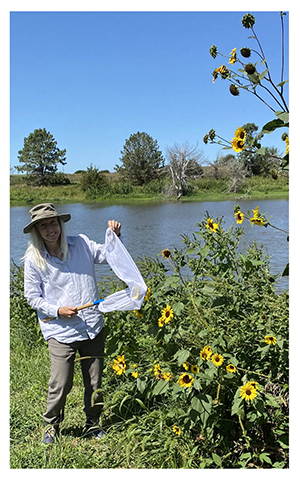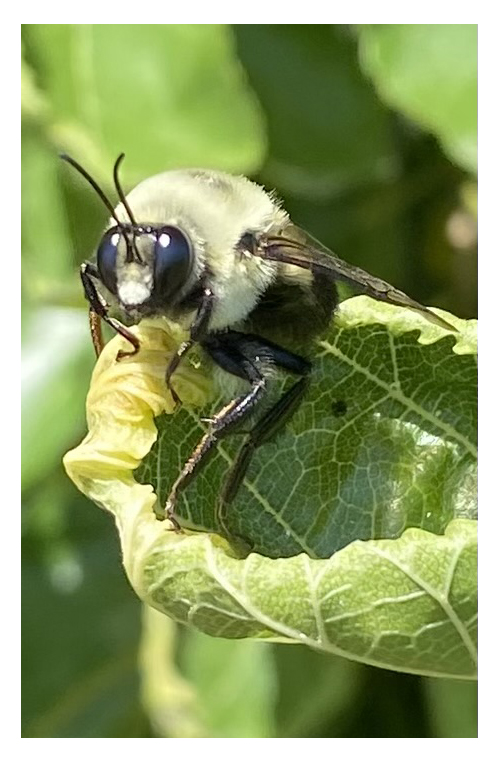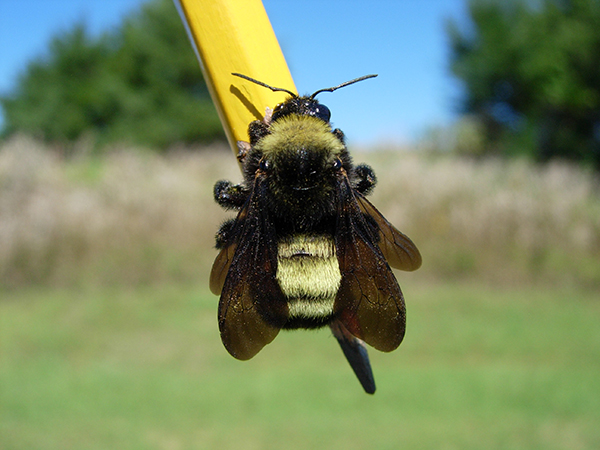Bee-autiful
 Pollinator Survey Conducted at Recreation Area
Pollinator Survey Conducted at Recreation Area
The sunflowers are blooming in tall clusters as two women weave through the thick vegetation along the bank of the lake at Pioneer Trails Recreation Area on a late summer afternoon. Dressed in long pants and wide brimmed hats, the pair gently swish long handled nets through the air in pursuit of their buzzing, golden quarry.
Patricia Slatin, a volunteer with the Nebraska Bumble Bee Atlas—a community science effort run by the Xerces Society for Invertebrate Conservation and Nebraska Game and Parks Commission— was on-site for the pollinator survey at Pioneer Trails. She was pleased with the quantity of bees and diversity of species the site offered, as she and fellow volunteer Diane Underwood were able to document five types of bees during their visit: Black and Gold Bumble Bee (Bombus auricomus), Southern Plains Bumble Bee (Bombus fraternus), Brown-belted Bumble Bee (Bombus griseocollis), Common Eastern Bumble Bee (Bombus impatiens), and American Bumble Bee (Bombus pensylvanicus).
“Both fraternus and pensylvanicus are species of conservation concern, so it was especially nice to find them at Pioneer Trails,” said Slatin, who has been documenting bees in central Nebraska since 2019.
Bee and habitat surveys, such as the one conducted at Pioneer Trails, are not harmful to the landscape or the animals. “The researchers walk around the prairie photographing plants in bloom, collecting bumble bees with a net, putting them into vials and chilling them in a portable cooler for a short time, photographing them, and then releasing them close to the place where they were caught,” explained Slatin. “The bees are not harmed by the photography process, and no bees are removed from the survey site.”
 According to the Xerces Society, pollinators are essential to the environment. The ecological service they provide is necessary for the reproduction of over 85 percent of the world’s flowering plants, including more than two-thirds of the world’s crop species. The United States alone grows more than 100 crops that either need or benefit from pollinators, and the economic value of these native pollinators is estimated at $3 billion per year in the U.S. Beyond agriculture, pollinators are keystone species in most terrestrial ecosystems. Fruits and seeds derived from insect pollination are a major part of the diet of approximately 25 percent of all birds, and of mammals ranging from red-backed voles to grizzly bears.
According to the Xerces Society, pollinators are essential to the environment. The ecological service they provide is necessary for the reproduction of over 85 percent of the world’s flowering plants, including more than two-thirds of the world’s crop species. The United States alone grows more than 100 crops that either need or benefit from pollinators, and the economic value of these native pollinators is estimated at $3 billion per year in the U.S. Beyond agriculture, pollinators are keystone species in most terrestrial ecosystems. Fruits and seeds derived from insect pollination are a major part of the diet of approximately 25 percent of all birds, and of mammals ranging from red-backed voles to grizzly bears.
Providing habitat for pollinators at NRD recreation areas is one way to safeguard these important creatures on the landscape. Documenting these species through surveys is a way to check for the health of the habitat and determine if conservation activities are effective.
To learn more about the results of the recent survey at Pioneer Trails, visit bumblebeewatch.org and click on Bumble Bee Maps. From there, you can select Nebraska and Pioneer Trails Recreation Area on the map.
If you are interested in improving prairie habitats in Nebraska on public and private lands for the benefit of pollinators and other creatures, check out Prairie Plains Resource Institute. You can also learn more about the pollinator habitat at Project GROW here.


